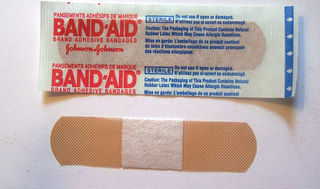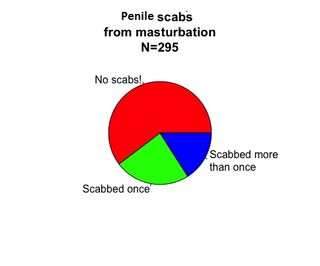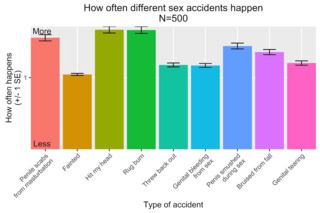
The modern anti-masturbation movement is predominantly heterosexual, White, and often strongly religious males. They oppose masturbation on the
grounds that masturbation to pornography has somehow diminished their manhood, and impaired their social lives and general success in life. Many of them report that frequent, daily masturbation to porn has caused them to have a host of problems, ranging from erectile dysfunction to even “scabs” or sores on their penis. There are two, tried and true, ways to make men wince and pause: threaten them with injury to their genitals, or tell them that their penis might simply stop working. Recent articles about the anti-masturbation movement have started to include both of these elements, with anecdotes about erectile dysfunction, along with tales of frequent masturbation resulting in “scabs” on the penis.
Nicole Prause, PhD., is a sexual scientist, who has gained significant attention in recent years for actually testing many of the claims of sex addiction and anti-pornography camps. Her research has demonstrated that people who watch higher levels of porn actually experience an increase in desire for sex with their current partner, not a decrease. Further, the brains of people watching porn show less “cue reactivity” to porn, rather than the increased reactivity that is so well-known it has been called a “biomarker” of drug/alcohol addiction.
In response to these recent anecdotes of masturbation-related injuries, Prause collected new data to test whether these injury stories truly did represent something rare, and potentially unique, about porn-fueled masturbation. She sat down with me, to discuss the project, and what to make of the data.
What led you to take on this recent, interesting and unique, investigation?
We have seen many claims of the “porn addiction” model falsified in recent years. One health claim offered in many men’s anecdotes was that they developed a “scab” on their penis and that somehow proved they were “addicted.” However, these stories actually are very common, and clinically unrelated to “porn.” Data are relatively easy to collect and test this idea.
How did you collect responses, and from where? How many respondents? Any demographics on respondents?
I scripted a questionnaire and requested an MTurk panel of 500 men and women to complete these few questions on “Sex Injuries.” MTurk panels are very commonly used in psychological research and are generally acceptable for scientific publications. We asked them to identify their gender (N=295 men), whether they had penetrative sex in the last year (N=412 “yes”), whether they had masturbated to orgasm in the last year (N=453 “yes”), how many minutes of sex films they viewed in the average week (Median=20), and whether they personally felt they had ever had an “addiction” to sex films (N=86 “yes”). We then asked them to answer whether they personally, or a person that they were being intimate with, had experienced each of a series of possible sex injuries “Never”, “Once”, or “More than once.”
What did you find? How common is it, for men to experience injuries to their penis from masturbation?
We found that the three most common sex injuries reported in this sample were (in order):
Hitting your head on an object during sex (127 happened once, 129 more than once)
Rug burn from the motion of sex (107 happened once, 133 happened more than once)
Advertisement

Source: By permission of Nicole Prause, PhD
The proportion reporting having a penile scab at least once was much higher when I limited the data to men reporting only (40%) than when I included the women in the sample (34.4%) from whom men might wish to hide such an injury.
I notice that your inquiry was about sex-related injuries, and not just about injury from masturbation. Why was that?
I have never seen base rates for sex injuries in an MTurk sample. The other behaviors were useful to interpret data in some context. Also, it is important to include both (a) injuries that were likely to be much more frequent and (b) injuries likely to be much less frequent than the behavior we were most interested in to reduce response bias.
What did you find, in the responses, about sex and injuries in general?
Rug burns, sores, and bleeding from sex could occur when one partner does not feel empowered to report their discomfort, but also can suggest very pleasurable immersion in a sex act. We are currently working on a new study of very high sexual arousal states to understand how some of this apparent inattention to one’s environment may look in the brain.

Source: By permission, Nicole Prause, PhD.
Advertisement
I would guess that sex injuries are commonly discussed amongst
friends, but rarely assessed by scientists. For example, a scab on the
penis due to high frequency masturbation could increase some risks of
infection, but, in the grand scheme of cancer, child hunger,
and other health concerns, I imagine most scientists are not especially
interested in studying something of such low health impact.Should we regard injuries from sex as a sign that someone is having unhealthy, or unsafe sex?
Masturbation itself appears about as safe as sexual gratification comes; masturbation is overwhelmingly associated with health benefits. These data leave the impression that sex injuries may just be a common part of learning about healthy sexual expression.
Just to be sure, we checked and there was no association between any injury during sex in the lifetime, including scabs on the penis from high frequency masturbation, and a feeling that one has had a problem of “addiction” to sex films. That reported association appears to be manufactured by anecdotal reports, which is why anecdotal reports are not acceptable in science.
In the interests of good science – are there limitations to these data? How much can we rely on them, as a valid measure of how common men experience penis-related injuries from masturbation?
As with any study, there are limitations to these data. The sample is not thought to be representative of any larger population, although MTurk samples themselves are fairly well-characterized. Since it was necessary to write the injury questions for the survey without a published guide, the questions also are not standardized and may have psychometric issues that are not known. Given that the sample is very large and this pattern of trying to create false health panic related to “porn” is so common (i.e., frontal dysfunction, erectile dysfunction, lack of emotional control, etc.), I am inclined to believe that this pattern would replicate.* As ever, more data could help clarify how exaggerated this latest health claim against sex films might be.
Advertisement
* Dr. Prause has no intention of spending the time to publish these
data in a peer-reviewed journal, but is happy to share the data with any
scientists who would like to review them, on request.************************
So there you have it. In contrast to hyperbolic stories, sex-related injuries are actually quite common. Sores, abrasions or sores on penises or genitals from masturbation are not evidence of addiction, loss of sexual control, or that one is sexually unhealthy. Instead, these injuries appear to be the result of engaging in a physical activity, which carries the risk of occasional injury to one’s body, whether it comes from sex, hiking, or walking up a set of stairs. Sex is a healthy, positive activity for most.
I will note that sores on one's genitals might be the result of masturbation, dry skin, infection, or from one's sexual techniques. Blaming such sores on "too much masturbation" might lead a person to not seek medical treatment, when they should. Don't assume these abrasions are innocuous, if they last, recur, or appear out of proportion to your sexual behaviors.
Louise Lush is an Australian feminist pornographer, activist and writer. A few years ago, scary stories were circulating about young teenage girls developing anal tearing from having sex with young men who’d been watching porn. Louise dug into this story, and identified that there was no evidence such injures were occurring, but that they were hyperbolic exaggerations of urban myths, meant to scare and manipulate. She coined the term “panicdotal evidence” (link is probably NSFW)to describe such stories.
Panicdotal stories about sexual injuries do only one thing: create shame and fear– they don’t reduce the chances of anyone having sex. They only reduce the chances that people will discuss their sexual injuries, for fear of being shamed, and judged unhealthy or addicted. Hopefully, now that there is data to demonstrate how common such injuries are, in normal, healthy peoples’ sex lives, we can reduce the fear and stigma associated with these experiences.

No comments:
Post a Comment